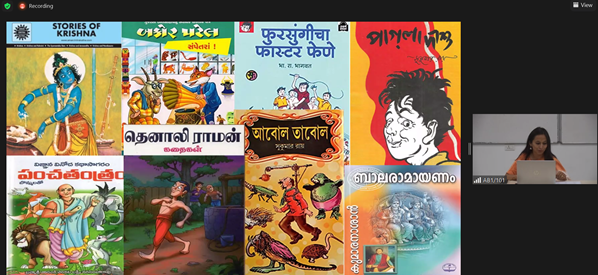STORY CREDITS
Writer/Editor: Shivangi Vasudev Bhatt
Photo: Media and Communication, IIT Gandhinagar
Bringing a crucial yet less talked about aspect of Indian literature to the centre, IITGN hosted two lectures that delved deeper into the variety and plurality of children’s literature in Indian languages in the precolonial era. The two lectures titled – ‘Between Impossibility and Possibility: Precolonial Children’s Literature in Indian Languages’ and ‘Female Voices in Children’s Literature in Gujarati’ – were delivered by Prof Diti Vyas on March 31 and April 1, 2022, respectively, as a part of the Institute’s Indian Knowledge Systems (IKS) elective course lecture series.
Highlighting the saliency of Indian children’s literature, in her first lecture Prof Diti Vyas said, “Indian children’s literature, developed within the boundaries of formal education after emerging as an independent body of writing, witnessed creativity, originality, and modernity in its works.” The history of children’s literature in different Indian languages is said to have started in the 19th century with the arrival of the British missionaries and the beginning of commercial printing. However, using examples like Panchatantra dating to about 200 BCE, Prof Vyas argued, “The whole body of highly organised writing for children in the precolonial era was either ignored or touched upon as a mere predecessor with no real value, and was severely criticised.” The intricate notions of double address (addressing the child and adult simultaneously) and constructive child (signifying that young people construct their own identity out of what is culturally available rather than being passive recipients) were prevalent in precolonial Indian children’s literature. Moreover, these texts posed questions, demanding scrutiny by children rather than providing readymade answers on a plate.
The second talk by Prof Vyas threw light on how the female characters in children’s literature of Indian regional languages were seen as stereotypical due to their adherence to the traditional roles of a daughter, mother, wife, and sister; typically characterised by dependence and passivity. Being a fundamental part of children’s literature, lullabies leave a substantial impact on the child’s psyche. Elaborating on this, Prof Vyas said, “Lullabies (Halardu: Gujarati), the first traditional lore available to children in the precolonial era, densely pack female cathartic and subversive energies. These cradle songs are as much for and about the mothers as they are for and about children.” Their orality gave mothers the power to improvise lullabies according to their requirements, expressing various moods and emotions. However, the transition to digital streaming platforms silenced feminist revisionary attempts, causing the mother’s voice to become a monotone. Prof Vyas also read out and explained some examples of lullabies in Gujarati. Both the talks concluded with lively Q/A sessions.
Prof Diti Vyas is an Associate Professor in the Writing and Communications Department at Anant National University. She has a rich experience of academic teaching, research, and consulting, spanning nearly two decades. Her doctoral research focusing on Indian children’s literature in English and regional languages received national and international accolades by bodies such as the International Research Society for Children’s Literature (IRSCL) and The Irish Society for the Study of Children’s Literature (ISSCL). She represents Gujarat in the collection of folktales, legends, and modern lore of India, ‘The Owl Delivered the Good News All Night Long’ by Aleph Book House.
This is the sixth edition of the Introduction to Indian Knowledge Systems elective course, IKS 2022, which is being held online on the theme ‘Precolonial India’s Treasure House of Literatures’. The course is open to students and anyone interested in India’s knowledge systems and cultural heritage. They can join the course for free by registering online at: http://iks.iitgn.ac.in/. All lectures will be live-streamed on IITGN’s YouTube channel. The course’s website will carry regular announcements and updates on the speakers and lectures.
This news has been covered by some of the leading Indian newspapers and media agencies. Click on the links below to read more.

